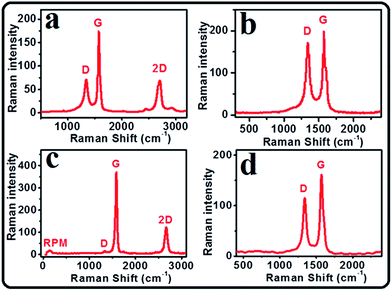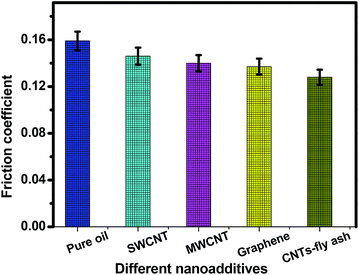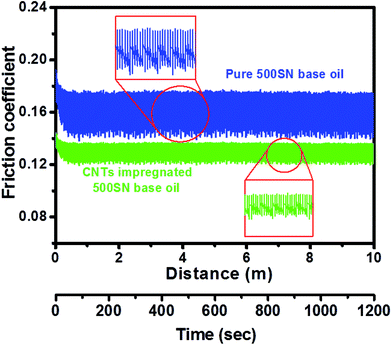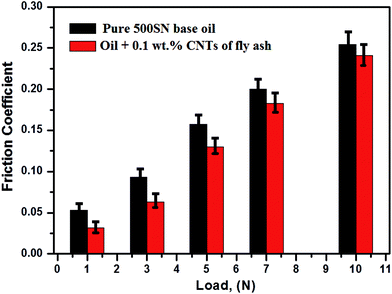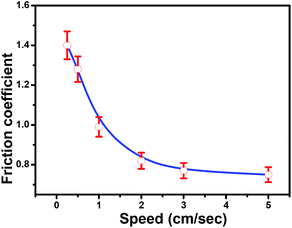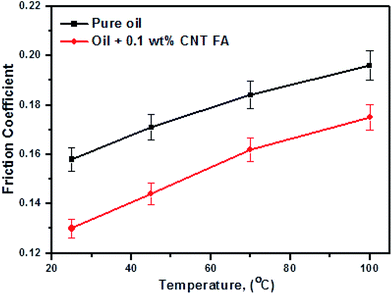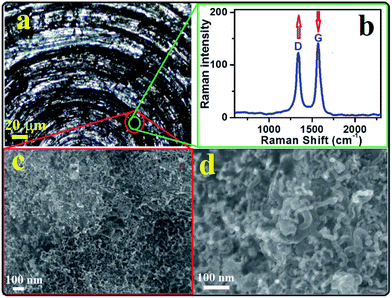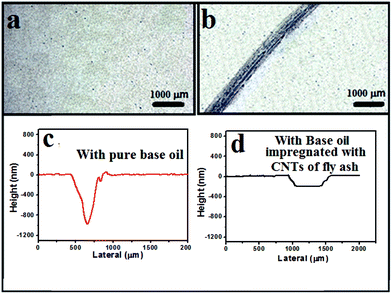 Open Access Article
Open Access ArticleCarbon nanotubes of oil fly ash as lubricant additives for different base oils and their tribology performance
Numan Salah *a,
M. Sh. Abdel-wahaba,
Ahmed Alshahrieab,
Najlaa D. Alharbic and
Zishan H. Khand
*a,
M. Sh. Abdel-wahaba,
Ahmed Alshahrieab,
Najlaa D. Alharbic and
Zishan H. Khand
aCenter of Nanotechnology, King Abdulaziz University, Jeddah 21589, Saudi Arabia. E-mail: nsalah@kau.edu.sa; alnumany@yahoo.com
bDept. Phys., Faculty of Science, King Abdulaziz University, Jeddah 21589, Saudi Arabia
cDept. Phys., Sciences Faculty for Girls, King Abdulaziz University, Jeddah 21589, Saudi Arabia
dDept. Applied Sciences and Humanities, Jamia Millia Islamia, New Delhi 110025, India
First published on 17th August 2017
Abstract
Oil fly ash has been reported to be a good source for the production of carbon nanotubes (CNTs). Recently, these CNTs were evaluated as lubricant additives in sunflower base oil and were found to exhibit excellent tribological properties. In this work, these CNTs were tested as lubricant additives in 100SN, 500SN and 150BS Saudi Aramco base oils. The results on other commercial carbon nanostructures like multiwall and single wall CNTs and graphene are also included in this study for comparison. Excellent tribological performance was obtained with CNTs of fly ash at a very small concentration. The observed reduction in values of the friction coefficient between two metallic surfaces using these CNTs was found to be superior to those of other carbon nanomaterials. The value of the friction coefficient was reduced by around 20% at a concentration of 0.1 wt%. These values were also investigated as a function of load, speed and temperature. The rheological behaviour showed that the viscosity of the 0.1 wt% CNTs-impregnated 500SN oil is almost invariant compared to that of the pure one. It is therefore suggested that CNTs of fly ash may be a good lubricant additive to minimize the friction and improve the fuel economy.
1. Introduction
Nanoscience and nanotechnology being an interdisciplinary area of research offers opportunities for scientists in different areas to explore the possibilities of new findings. Several nanostructures have been produced and studied for use in different systems and devices. Amongst them carbon nanostructures have received huge attention and have been extensively produced and investigated. One of the interesting carbon nanomaterials is carbon nanotubes (CNTs),1 which have been widely studied and evaluated for different applications. A carbon nanotube is a tubular structure having hexagonal rings of carbon atoms. These tubes can reach up to millimeters in length and have diameters in the nanometer scale. This structure, in addition to their excellent mechanical properties, could attract much attention for utilizing CNTs in a variety of applications. A number of procedures and methods have been developed to synthesis CNTs.2–10 However, the mass production of this nanomaterial using these methods is still an issue. Due to limited success in the large scale production and cost effectiveness of CNTs, they could not be included with the wide range of cost effective products made from polymers or rubber. Therefore, many research groups from different institutes are still working to find out a suitable, simple and cost effective method using cheap precursors for CNTs synthesis so that this important nanomaterial could be produced at a large scale for variety of applications.One of the recent reports suggesting the production of carbon nanotube using oil fly ash at large scale is interesting and may open up the possibilities for industrial applications of CNTs. It has been reported that this important nanomaterial can be produced using the chemical vapor deposition (CVD) method by utilizing oil fly ash as a catalyst and co-precursor in the same time.11,12 This ash is available in huge quantities as a solid waste and has a good amount of unburned carbon, which is more than 80%.13 This solid waste carbon rich material is not yet tried to be utilized as a source for nanostructures production. Salah and his group11,12 showed the conversion of this fly ash into CNTs and utilized them for different applications. Further, they reported that pure carbon content in the oil fly ash is high, which has been extensively evaluated for the conversion into nanostructures and utilized for variety of applications.
Manufacturers of cars engines and similar machines are continuously are focussing on the design of engines with minimum fuel consumption and maximum kinetic energy. One of the most important solutions is to use high efficiency lubricants. These lubricants are mostly made from mineral-based oil, which is produced by “petroleum extraction and synthetic-based oil”. One of the most common lubricant oil is the engine oil. It is used at large scale mainly for reducing friction and then fuel consumption. It is useful also as “a coolant, cleaning the trapped particles from machinery sheds, and as a sealant that could block the surface from contaminants”. Manufacturers of lubricant oils normally use to add a chemical additive for improving the tribological performances. But, the search is continued for better chemical additive to improve the tribological performances (i.e. lubrication, friction and wear).
A number of research groups have employed different nanoscale materials as lubricant additives to enhance the tribological performances. For instance, TiO2, CuO and nanodiamonds were studied as additives by Wu et al.14 Amongst these nanostructures, CuO nanoparticles provided better result. The results showed that the friction coefficient was reduced by 18.4% as compared to that of standard base oils. Diamond and SiO2 nanoparticles were also evaluated as additives by Peng.15 They also found that “both the nanoparticles used as additives in liquid paraffin in small concentrations showed better anti-wear and anti-friction properties than that of pure paraffin oil”. Zhang et al.16 studied “CaCO3 nanoparticles as additives in blank PAO (poly-alpha-olefin) and PAO containing CaCO3 nanoparticles”. They reported that these nanostructures significantly improved the tribological performance of PAO base oil. Still a lot of work is focussed on the evaluation of variety of nanostructure additives. However, there are many challenges such as the cost of these nanostructures and their poor mechanical properties, which are not still addressed and requires rigorous studies in this direction.
Carbon nanotubes have been recognized as excellent additives in lubricant oils. They are also found to be suitable for studying the sliding wear behaviour of other lubricant materials. The use of CNTs as lubricant additives has been reported by several groups.8,17–20 Self-lubricating metallic nanocomposites reinforced by different nanomaterials including CNTs have also been reported.21,22 Although the quantities needed (percentage) as additives are small, the cost of CNTs is still a big challenge. The agglomeration associated with CNT dispersion limits the use of this material at large scale. Recently, we have reported the results on use of CNTs of carbon rich fly ash as a lubricant oil additive.23 These nanotubes were evaluated as lubricant additives in a sunflower base oil. Excellent tribological results were observed by using these CNTs. In this work, CNTs produced from oil fly ash have been evaluated as lubricant additives in Saudi Aramco base oils. These oils include 100SN, 500SN and 150BS, which are quite popular as lubricant oils used for car engines and other machines. Other commercial carbon nanostructures like multiwall, single wall CNTs and graphene were also included in this study for comparison. The CNTs of oil fly ash along with the other commercial carbon nanostructures are dispersed in the above mentioned base oils, and then the friction coefficient values are measured and investigated in more details. The result of fly ash CNTs are found to be superior as they could significantly reduce value of the friction coefficient. These results suggest that the CNTs of fly ash can be considered as an ideal lubricant additive.
2. Experimental
2.1. Materials synthesis
The synthesis of carbon nanotubes of oil fly ash was adopted by the same method described earlier.11,12 They were grown using the low pressure chemical vapor deposition technique. Fly ash powder, which has been used as a catalyst and co-precursor for CNTs growth was collected from the Jeddah power plant (Saudi Arabia). The other carbon nanomaterials, which are multiwall, single wall CNTs and graphene were obtained from Ad-Nanotech, India (http://www.ad-nanotech.com/). They were used without further treatment or functionalization. The samples were characterized by scanning electron microscope and Raman spectroscopy. The used lubricant oils in this experiment were collected from Petroment Company (Jeddah, Saudi Arabia). The raw materials of Petroment base oil was obtained from Saudi Aramco Company. Three different base oils were included in this study, which are 100SN, 500SN and 150BS. The specifications of these oils are listed in Table 1.| No. | Parameters | ASTM | Unit | 100SN | 500SN | 150BS |
|---|---|---|---|---|---|---|
| 1 | Color (max) | D-1500 | — | 1.0 | 2.5 | 5 |
| 2 | Density@15 °C | D-1298 | kg m−3 | TBR | TBR | TBR |
| 3 | Appearance | Visual | — | C & B | C & B | C & B |
| 4 | Kinematic viscosity at 40 °C | D-445 | cSt | 18.5/23.0 | 91–101 | — |
| 5 | Kinematic viscosity at 100 °C | D-445 | cSt | — | — | 31–33 |
| 6 | Viscosity Index (min) | D-2270 | — | 100 | 97 | 95 |
| 7 | Flash point COC (min) | D-92 | °C | 199 | 210 | 232 |
| 8 | Pour point (max) | D-97 | °C | −18 | −6 | −6 |
| 9 | Conradson carbon residue (max) | D-189 | % M | — | 0.1 | 0.7 |
| 10 | Neutralization # (max) | D-974 | mg KOH per g | 0.05 | 0.05 | 0.05 |
| 11 | Copper corrosion (max) | D-130 | 100 °C/3 h | 1A | 1A | 1A |
| 12 | Sulfur content (max) | D-2622 | % M | 1.0 | 1.3 | 1.6 |
| 13 | Ash content (max) | D-482 | wt% | 0.01 | 0.01 | 0.01 |
2.2. Friction coefficient measurements
The friction coefficient values were measured at room temperature using a Tribometer model, TRB-S-DE-0000 CSM Instruments, Switzerland. The protocol used for these measurements are similar to those reported earlier.23 Specific amount of the desired nanomaterial according to the calculated concentration was included into the base oil and the dispersion was assisted by stirring the mixture for 1 h followed by sonication for another 1 h. The ball-on-disk test was used at the desired applied load with a rotation on the disk at diameters in the range 2–5 mm. The used substrate was of polished steel, while the balls are of 6 mm coated with 100 Cr steel”. The measurements were conducted at a linear speed 0.5 cm s−1 with a 10 m sliding distance. The friction coefficient readings of the minimum, maximum and mean values were recorded. Different concentrations by weight of the as-grown CNTs of oil fly ash were dispersed in 500SN base oil and were evaluated to optimize the best concatenation for minimum friction. The friction coefficient values for CNTs of oil fly ash were also studied as a function of load, speed and temperature. The average value of the data recorded from three tests was taken every time. The presented results show only the average values of these measurements. The rheological measurements were performed in the temperature range 25–100 °C using an AR-G2 Rheometer.3. Results and discussion
Fig. 1 shows SEM images of graphene, MWCNT, SWCNT and CNTs of oil fly ash recorded at the same magnification (images (a), (b), (c) and (d), respectively). As evident from image (a), the used graphene in this experiment has multilayers appearing in cluster forms, while the MWCNT (image b) have diameters in the range 40–50 nm and several micrometers of lengths. In case of SWCNT (image c), they are in big entangled forms with diameters below 10 nm. The CNTs of fly ash shown in image (d) are similar to those reported earlier.11,23,24 They have diameters within the range 20–30 nm and lengths ranging from 1 to 5 μm. Raman spectra of these carbon nanomaterials samples i.e. graphene, MWCNT, SWCNT, and CNTs of fly ash, were also recorded and are presented as Fig. 2(a–d). These spectra show the usual peaks of the corresponding carbon nanostructures. The obtained results are in accordance with those reported in the literature. The G, D and 2D bands of these graphitic materials were observed at their regular positions at 1575, 1340 and 2680 cm−1 respectively.25–27 The RPM breathing mode of SWCNT is also shown at 142 cm−1.28 These results confirm that these carbon nanomaterials have perfect structures.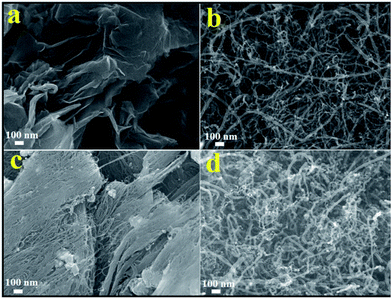 | ||
| Fig. 1 SEM images at the same magnification of (a) graphene (b) MWCNT, (c) SWCNT and (d) CNTs of oil fly ash. | ||
The carbon nanomaterials were tested as additives in a typical base oil, which is 500SN. The obtained results for the friction coefficient values were recorded and tabulated in Table 2. The base oil 500SN has been selected to identify the best carbon nanostructure in term of friction reduction at a fixed concentration, which is 0.1 wt%. This concentration was found to be the optimum for obtaining the best lubrication result in our earlier study.23 The friction coefficient for the start, minimum, maximum and mean values are shown in Table 2. These values were recorded at a fixed load, which is 4 N. The mean value for the pure oil is found to be 0.158. This value was observed to decrease on the addition of the above additives. The minimum value for the friction coefficient was observed by adding CNTs of fly ash, which is 0.129. The other carbon nanostructures i.e. SWCNT, MWCNT and graphene showed relatively smaller reduction. Fig. 3 represents a plot of the mean friction coefficient values for these nano additives mixed in 500SN base oil at a concentration of 0.1 wt%. This figure clearly shows that CNTs synthesized from oil fly ash have the best result, which is in agreement with earlier results on the application of CNTs of oil fly ash in the sunflower oil.23
| Sample | Friction coefficient values | ||||
|---|---|---|---|---|---|
| Start | Min | Max | Mean | SD | |
| Pure oil | 0.188 | 0.130 | 0.201 | 0.158 | ±0.014 |
| SWCNT | 0.136 | 0.129 | 0.198 | 0.144 | ±0.018 |
| MWCNT | 0.148 | 0.123 | 0.212 | 0.138 | ±0.014 |
| Graphene | 0.154 | 0.120 | 0.205 | 0.135 | ±0.014 |
| CNTs-fly ash | 0.143 | 0.110 | 0.182 | 0.129 | ±0.015 |
The above results showed that CNTs of fly ash has the best lubrication performance amongst other carbon nano-additives and is evaluated in other base oils of Saudi Aramco. The results presented in Table 3 show the friction coefficient values for pure and CNTs of fly ash impregnated base oils of 150BS, 100SN and 500SN. These oils were mixed with CNTs of fly ash at a concentration of 0.1 wt%. A considerable reduction in values of the friction coefficient by adding this tiny concentration of fly ash-CNTs into these base oils was observed. The reduction in the values of the friction coefficient in case of 100SN and 500SN is relatively higher than that of 150BS base oils. This difference may be related to the nature of these oils and their viscosities. Nanocomposites made of graphene oxide (GO) nanosheets and copper borate (CuB) nanoparticles were recently reported by Li et al.29 to improve the tribological properties of the base oil 150SN, 100SN and 500SN. They reported a good dispersion stability of the nanocomposites in the base oil after their modification with oleic diethanolamide, however, the used additive concentration was high, which is 4.0 wt%. In the present study, a very tiny concentration of fly ash-CNTs i.e. 0.1 wt% has significantly decreased the friction between the two sliding surfaces. Moreover, these CNTs were used as synthesized without any modifications or functionalization. This may be a unique property of CNTs produced from fly ash. The inclusion of some active radical sites in CNTs were reported earlier.23 Such radicals could enable the CNTs to be adhered into the metal surface, which results in the reduction of friction.
| Oils + CNTs-fly ash | Friction coefficient values | ||||
|---|---|---|---|---|---|
| Start | Min | Max | Mean | SD | |
| Pure 150BS | 0.171 | 0.025 | 0.262 | 0.145 | ±0.017 |
| CNTs + 150BS | 0.171 | 0.193 | 0.373 | 0.125 | ±0.016 |
| Pure 100SN | 0.149 | 0.066 | 0.309 | 0.152 | ±0.019 |
| CNTs + 100SN | 0.187 | 0.020 | 0.247 | 0.119 | ±0.016 |
| Pure 500SN | 0.188 | 0.130 | 0.201 | 0.158 | ±0.014 |
| CNTs + 500SN | 0.143 | 0.110 | 0.182 | 0.129 | ±0.015 |
The mean values for the friction coefficient were also plotted for the CNTs impregnated 500SN base oil as a function of CNTs concentrations (Fig. 4). The figure shows a drastic drop in values of the friction coefficient below 0.1 wt%. Beyond this value, this curve starts to gradually increase. The pure oil samples and CNTs impregnated 500SN base oil are also shown in the inset of Fig. 4. A homogeneous dispersion of the CNTs within the 500SN base oil can be observed. It is quite interesting to get the optimum value for less friction at tiny concentration of CNTs i.e. 0.1 wt%. It is possible that the higher concentrations of these nanotubes could form large clusters.17,30 The clusters may be formed and agglomerate within the oil as a result of the overlapping over each other. Also there may be some attractive forces existing between the surfaces of these CNTs.23 These clusters are expected to have less satiability between the two sliding surfaces during the motion as compared with individual nanotubes, thereby showing higher frictions. Small consternations of fly ash CNTs (<0.1 wt%) perhaps will not be enough to protect the surface. In other words, there will not be enough material to cover the surfaces completely and reduce the friction between them (i.e. some gaps and holes on the surfaces will be their). These observations are similar to those reported by other workers.17,30
Fig. 5 shows a plot of the friction coefficient values against time and distance for pure and CNTs of fly ash impregnated 500SN base oil at a typical concentration (0.1 wt%). The plots in the insets are the corresponding extended views for these curves. The steady states are observed in these curves on the whole range, which is 10 m. It is clear from this figure that the fluctuation in the curve of CNTs impregnated 500SN base oil is much smaller than that of the pure oil. This is a remarkable result, which may be due to the reduction in the surface roughness. The presence of these nanostructures can smoothen the surface and minimize its roughness. In other words, these nanostructures will fill the gaps and holes in the surface, which results in less fluctuation in value of the recorded friction coefficient. High surface roughness is well known to show high fluctuation in values of the friction coefficient.31 These nano-additives may provide a solution to minimize this fluctuation by putting a protective layer. Ideally, this layer should be of a material that have high mechanical strength to bear the high loads and protect the surfaces during the sliding motion. The extended values for this curve shown in the inset of Fig. 5 have uniform repeating patterns, which may be a good indication for the formation of uniform portative layers with no clusters. The presence of clusters within the formed layer on the surface may show non-uniform and higher fluctuations.
The mean values of the friction coefficient for pure and CNTs impregnated 500SN base oils (at 0.1 wt%) were recorded as a function of load. The obtained results were plotted and presented in Fig. 6. With increasing the load from 1 to 10 N, the friction coefficient value was observed to increase from around 0.053 to 0.255 for pure 500SN base oil and from 0.031 to approximately 0.227 for CNTs impregnated base oil. It is clear that the CNTs impregnated oil show improved tribological performance at different loads as compared to that of the pure oil. The increase in values of the friction coefficient as a function of load is well documented in the literature32 and may be attributed to the nanostructures deformations, which enhances the rolling effect. Nevertheless, addition of small amount of CNTs into these base oils also gives a considerable reduction in the friction coefficient values under different loads.
The sliding speed has a great influence on the friction coefficient values using lubricant oils. Fig. 7 represents a plot for the mean values of the friction coefficient as a function of speed for CNTs impregnated 500SN base oil. The sliding speed was changed from 0.025 to 5 cm s−1. It is observed that the friction coefficient value was decreased by increasing the speed, particularly at low speeds. This value was dropped from around 0.141 at a speed of 0.025 cm s−1 to approximately 0.075 at 5 cm s−1. This result is almost in agreement with the Stribeck curve and the observed trend is in agreement with that reported in the literature.33 The super lubricity may not be achieved in this case. The two sliding surfaces in the present study have some considerable roughness; therefore, even if the speed reaching to high values, a measurable friction will still be there.
Fig. 8 represents a plot for the mean values of the friction coefficient as a function of temperature for pure and fly ash CNTs impregnated 500SN base oil. The obtained results were recorded at a concentration of 0.1 wt% and a load of 4 N. The friction coefficient values were observed to increase by increasing the temperature. They were increased from 0.158 to 0.192 by increasing the temperature from 25 to 100 °C for the pure base oil, and from 0.129 to 0.172 for the CNTs impregnated base oil. The rate of increases in both cases is almost similar. The increase in values of the friction coefficient may be due to the decrease in lubricant viscosity over this temperature range. This decrease in the viscosity may be due to the thermal decomposition of the lubricant oils molecules. Similar observations were also reported in the literature and the results were attributed to the decrease in lubricant viscosities.34 In the present case, the CNTs of fly ash may have less stability within the oil. Also, they may be less bonded with the molecules of the lubricant oil, particularly at high temperatures, thereby shows lower ability to make protective layers on the surface.
Fig. 9(a) shows a high resolution optical microscopy image of the used disk in this work after the measurement. Raman spectrum of the CNTs layer after the test is shown in Fig. 9(b). SEM images of the formed layer of CNTs on the disk under a load of 4 N are also shown in Fig. 9(c and d). These images were obtained at two different magnifications. It is clear that the length of these CNTs after the test were significantly reduced as compared to those shown above in Fig. 1(d). The intensity ratio of the G/D bands of Raman signals was also decreased. The formed layer of fly ash-CNTs on this disk could acts as an effective protection layer, which results in the observed friction reduction. These nanotubes could be easily aligned under the applied load and may form this layer. It is well established that carbon nanostructures included in lubricants can form strong protective layers between sliding surfaces.35 The formed layer in the present case still contains CNTs, but with shorter lengths. With the formation of such layer under the applied load some distraction in the CNTs can be noticed. Not only the length of these nanotubes becomes shorter, but the graphitic content in these nanotubes were also affected. The D band in Raman spectrum (Fig. 9(b)) becomes more prominent as compared to that of the original D band of this sample (Fig. 2(d)). However, the CNTs of fly ash still show graphitic structure. They were not completely deformed or formed into new transferred layers.
To study the track formation and wear loss, the friction coefficient was measured at room temperature with an applied load of 10 N and 10 m sliding distance. This measurement was performed for pure as well as fly ash-CNTs impregnated 500SN base oil. Dimensions of the formed tracks on the worn surfaces were measured by a surface profiler. Fig. 10(a and b) shows images of the disk before and after the test. The worn surface on the disk used with the use of only pure oil as a lubricant is shown in Fig. 10(c). The formed wear track on the disk has average depth and width, which is equal to 970 nm and 210 μm, respectively. On the other hand, the worn surface of the used disk in the presence of fly ash-CNTs within the base oil (Fig. 10(d)) has almost shallow track with average depth and width of 200 nm and 450 μm, respectively. It is clear that there is a significant reduction in the wear volume by using CNTs as additive in the 500SN base oil. The specific wear rate values (specific wear coefficient) were calculated in both cases using the equation:
The obtained results for the specific wear rate values for both the cases (i.e. with pure and fly ash-CNTs impregnated base oil) were found to be 20.37 × 10−13 and 9 × 10−13 m3 N−1 m−1, respectively. These noticable wear loss can be attributed to the presence of protective thin layers made from CNTs of fly ash. Similar improvements in the wear volume were also reported in the literature.36
Carbon nanotubes are ideal lubricant additives due to their excellent mechanical properties. However, these CNTs showed a significant loss in their graphitic structure after the use. It has been reported that these nanomaterials can form a transfer layer of amorphous carbon.37 In the present study, CNTs of oil fly ash retained major content of graphitic structure after mixing. These are remarkable results indicating that the CNTs of fly ash presents a unique structure. The results of CNTs of fly ash as a lubricant additive in Aramco base oils were found to be superior to those of other carbon nanomaterials. They could significantly reduce value of the friction coefficient by around 20% at a very tiny concentration. The reason for superiority of fly ash-CNTs was explained earlier,23 which may be attributed to “the existence of active radical sites on the side wall of CNTs. These radicals might help the CNTs to adhere to the metal surface, thus reducing friction”.
Rheological behaviour is another important factor needs to be investigated in the CNTs of fly ash impregnated base oil. A typical concentration i.e. 0.1 wt% of CNTs was included in the 500SN base oil and then investigated “with the help of the temperature dependence of viscosity plot”. Fig. 11 shows the obtained values of viscosity at a certain range of temperature for pure and CNTs-impregnated 500SN base oil. In case of pure oil, the viscosity value was observed to decrease from 0.124 to around 0.008 Pa s by increasing the temperature from 25 to 100 °C. The CNTs impregnated in 500SN base oil showed similar behaviour, but with a small decrease in the viscosity values by around 12%, particularly at the low temperatures side. These results showed that the viscosity of the CNTs-impregnated base oil show only a small change in comparison to that of the pure oil. Similar results were also reported on the literature about the low effect of CNTs on the viscosity of the lubricant oil with different temperatures.37 From the application point of view, the obtained results showed that CNTs of fly ash may be recommended as a good additive in lubricant oils, used for different engines. Moreover, the low cost CNTs obtained from waste materials beside their well-dispersion within the base oil is another remarkable finding.
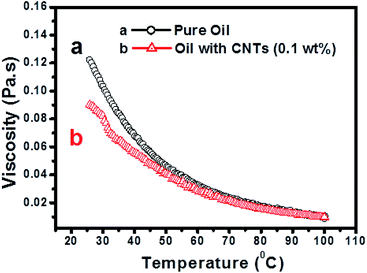 | ||
| Fig. 11 Viscosity as a function of temperature for pure and 0.1 wt% CNTs of fly ash impregnated 500SN base oil. | ||
4. Conclusions
In this work, CNTs produced from oil fly ash were evaluated as lubricant additives in 100SN, 500SN and 150BS Saudi Aramco base oils. The obtained results were compared with those of other commercial carbon nanostructures like MWCNT, SWCNT and graphene. Excellent tribological performance was observed with CNTs of fly ash at a very small concentration. The results obtained on the use of CNTs of fly ash were found to be superior to those of other carbon nanomaterials. The value of the friction coefficient was reduced by around 20% at a concentration of 0.1 wt%. The friction coefficient value was observed to increase with increasing the load and temperature in both pure and CNTs impregnated oil, but it was decreased by increasing the rotation speed. The rheological behavior showed that the viscosity of the 0.1 wt% CNTs-impregnated base oil remains almost invariant compared to that of the pure base oil. These results suggest that the CNTs of fly ash are ideal lubricant additives for different base oils and may be used for a broad range of lubricants.Conflicts of interest
“There are no conflicts to declare” under a “Conflict of interest”.Acknowledgements
This project was funded by the Deanship of Scientific Research (DSR) at King Abdulaziz University, Jeddah, under grant no. RG-1-194-37. The authors, therefore, acknowledge with thanks DSR for technical and financial support.References
- S. Iijima, Nature, 1991, 354, 56–58 CrossRef CAS.
- T. W. Ebbesen and P. M. Ajayan, Nature, 1992, 358, 220–221 CrossRef CAS.
- S. S. Cui, P. Siegmund, C. D. Schneider, K. Risch, S. Klötzer, L. Spiess, H. Romanus and J. Schawohl, Carbon, 2004, 42, 931–939 CrossRef CAS.
- Y. Y. Tsai, J. S. Su, C. Y. Su and W. H. He, J. Mater. Process. Technol, 2009, 209, 4413–4416 CrossRef CAS.
- P. J. F. Harris, Carbon, 2007, 45, 229–239 CrossRef CAS.
- A. A. Stramel, M. C. Gupta, H. R. Lee, J. Yu and W. C. Edwards, Opt. Lasers Eng., 2010, 48, 1291–1295 CrossRef.
- F. Kokai, I. Nozaki, T. Okada, A. Koshio and T. Kuzumaki, Carbon, 2011, 49, 1173–1181 CrossRef CAS.
- M. Jamshidijam, A. Akbari-Fakhrabadi, S. M. Masoudpanah, G. H. Hasani and R. V. Mangalaraja, Tribol. Trans., 2013, 56, 827–832 CrossRef CAS.
- S. Zanganeh, M. Torabi, A. Kajbafvalac, N. Zanganeh, M. R. Bayati, R. Molaei, H. R. Zargar and S. K. Sadrnezhaad, J. Alloys Compd., 2010, 507, 494–497 CrossRef CAS.
- J. Zhang, R. Tu and T. Goto, Mater. Lett., 2011, 65, 367–370 CrossRef CAS.
- N. A. Salah, Method of forming carbon nanotubes from carbon-rich fly ash, US Patent Number: 8,609,189 B2, 2013.
- N. Salah, S. S. Habib, Z. H. Khan, A. A. Al-ghamdi and A. Memic, Mater. Manuf. Processes, 2016, 31, 146–156 CrossRef CAS.
- S. S. Habib, Int. J. Nano Biomater., 2009, 2, 437–441 CrossRef CAS.
- Y. Y. Wu, W. C. Tsui and T. C. Liu, Wear, 2007, 262, 819–825 CrossRef CAS.
- D. X. Peng, Tribol. Int., 2009, 42, 911–917 CrossRef CAS.
- M. Zhang, X. Wang, X. Fu and X. Yanqiu, Tribol. Int., 2009, 42, 1029–1039 CrossRef CAS.
- S. Bhaumik, S. Prabhu and K. J. Singh, Adv. Tribol., 2014, 2014, 341365 Search PubMed.
- W. Wang, J. Huang, W. Li, Y. Jin and F. Wei, Lubr. Sci., 2015, 27, 451–461 CrossRef CAS.
- M. N. Çöl, O. N. Çelik and A. Sert, Arch. Comput. Mater. Sci. Surf. Eng., 2014, 67, 53–59 Search PubMed.
- N. Salah, S. S. Habib, Z. H. Khan, A. Memic and M. N. Nahas, Dig. J. Nanomater. Biostruct., 2012, 7, 1279–1288 Search PubMed.
- A. D. Moghadam, E. Omrani, P. L. Menezes and P. K. Rohatgi, Composites, Part B, 2015, 77, 402–420 CrossRef.
- E. Omrani, A. D. Moghadam, P. L. Menezes and P. K. Rohatgi, in Ecotribology, ed. J. Paulo Davim, Springer International Publishing, 2016, pp. 63–103 Search PubMed.
- N. Salah, M. S. Abdel-wahab, Z. H. Khan and S. S. Habib, Tribol. Trans., 2017, 60, 166–175 CrossRef CAS.
- N. Salah, S. S. Habib, Z. H. Khan, A. A. Al-ghamdi and A. Memic, Mater. Manuf. Processes, 2016, 31, 146–156 CrossRef CAS.
- Y. Wang, J. Li, L. Wang and J. Chen, Tribol. Trans., 2013, 56, 333–341 CrossRef CAS.
- L. Li, B. An, A. Lahiri, P. Wang and Y. Fang, Carbon, 2013, 65, 359–364 CrossRef CAS.
- N. Salah, A. Alshahrie, J. Iqbal, P. M. Z. Hasan and M. S. Abdel-wahab, Tribol. Int., 2016, 103, 274–280 CrossRef CAS.
- F. Zhang, P. Hou, C. Liu, B. Wang, H. Jiang, M. Chen, D. Sun, J. Li, H. Cong, E. I. Kauppinen and H. Cheng, Nat. Commun., 2016, 7, 11160 CrossRef CAS PubMed.
- W. Li, Z. Cheng and Z. Liu, RSC Adv., 2016, 6, 110866–110873 RSC.
- D. L. Curasu, C. Andronescu, C. Pirva and R. Ripeanu, Wear, 2012, 290–291, 133–139 Search PubMed.
- C. Shillingford, N. MacCallum, T. Wong, P. Kim and J. Aizenberg, Nanotechnology, 2014, 25, 014019 CrossRef PubMed.
- L. Wu, Y. Zhang, G. Yang, S. Zhang, L. Yu and P. Zhang, RSC Adv., 2016, 6, 69836 RSC.
- J. Li, C. Zhang, M. Deng and J. Luo, RSC Adv., 2015, 5, 63827–63833 RSC.
- W. Moon and J. Lee, Korea-USA Tribology Symposium, 1995, vol. 10, pp. 243–249 Search PubMed.
- D. Berman, A. Erdemir and A. V. Sumant, Mater. Today, 2014, 17, 31–42 CrossRef CAS.
- B. Wang, X. Wang, W. Lou and J. Hao, J. Phys. Chem. C, 2010, 114, 8749–8754 CAS.
- J. A. C. Cornelioa, P. A. Cuervo, L. M. Hoyos-Palacio, J. Lara-Romero and A. Toro, J. Mater. Res. Technol., 2016, 5, 68–76 CrossRef.
| This journal is © The Royal Society of Chemistry 2017 |

